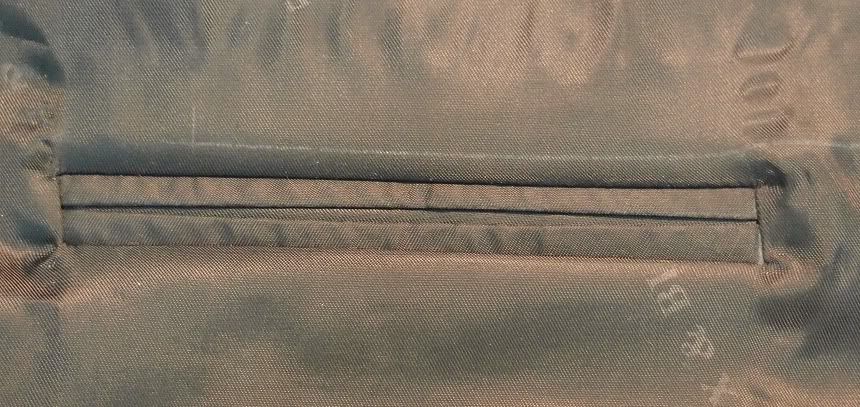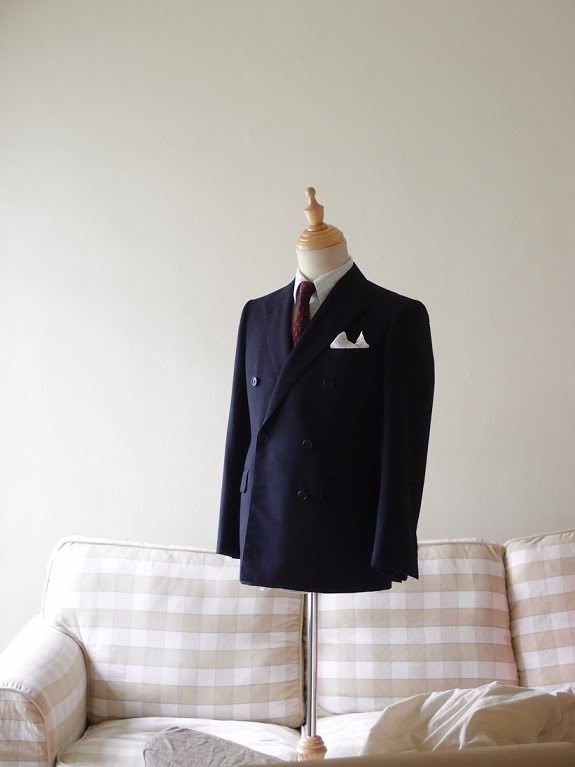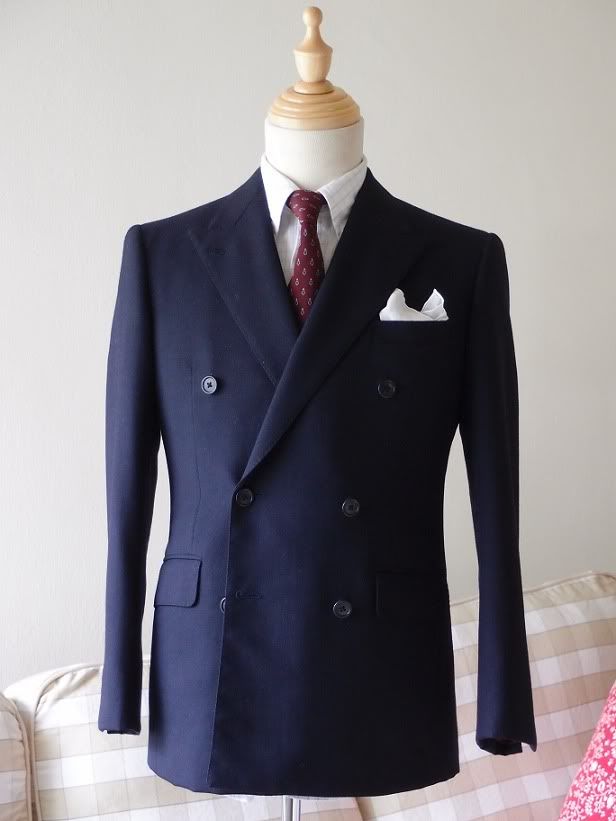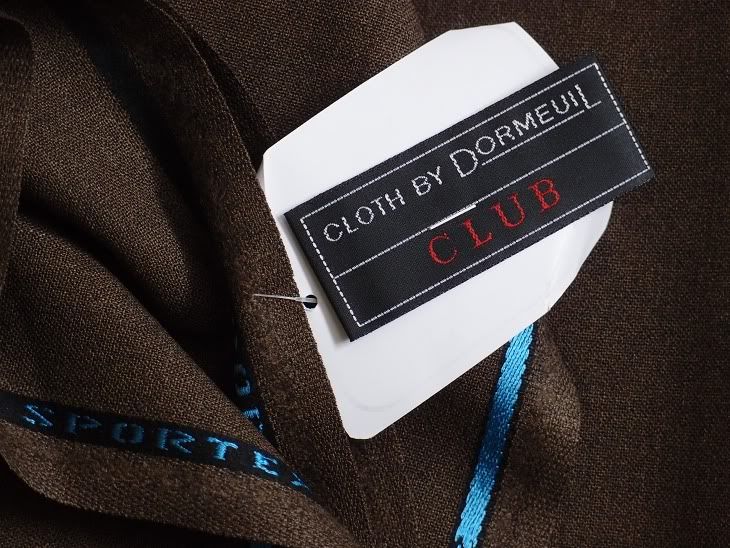Friday, September 30, 2011
Saturday, September 24, 2011
My first lesson
"How long do you think it will take?" the stooped bespectacled partner of my sifu asked. "One year?"
"Longer," replied my sifu. They were talking about how long my apprenticeship will last.
The first task given to me was sewing long seams. "In tailoring, you have to use technique to compensate for the shortcomings of equipment and materials," remarked my sifu. "The feed mechanism of the sewing machine causes the two pieces of cloth to have different lengths once sewn up. That's why you have to keep the bottom piece taut and the top piece easy." So that's what's causing all my machine sewing woes.
By my seventh long seam, I asked him if it's OK to put this much tension on the cloth while I sew. "You have to develop your own technique. Everyone does it differently. Everyone eventually finds their own way of doing it."
Controlling the speed of an industrial sewing machine is extremely tricky. Everything about it is optimized for the professional sewer. I imagine it's like trying to drive a F1 car.
After lunch, he showed me how to make "lei toi", the inner jacket pockets. I watched in amazement as he made one in 5 minutes or so, may God have mercy upon me.
By the time I left at 4:30 p.m. I have made 3 welted inner pockets, and all three were wretched. I have come to the conclusion that I cannot make these pockets with his technique. I need more "scaffolding" -- some basting stitches to hold pieces together instead of three pieces of cloth held together merely by the pressure of a fingertip, use of glass-head pins to position cloth, use of chalkmarks to help me feed them accurately through the F1 machine, etc. The sifu uses almost no chalk marks. He uses no pins. He even echews the ruler. Everything is by sight and feel. The guy is crazy.
"Longer," replied my sifu. They were talking about how long my apprenticeship will last.
The first task given to me was sewing long seams. "In tailoring, you have to use technique to compensate for the shortcomings of equipment and materials," remarked my sifu. "The feed mechanism of the sewing machine causes the two pieces of cloth to have different lengths once sewn up. That's why you have to keep the bottom piece taut and the top piece easy." So that's what's causing all my machine sewing woes.
By my seventh long seam, I asked him if it's OK to put this much tension on the cloth while I sew. "You have to develop your own technique. Everyone does it differently. Everyone eventually finds their own way of doing it."
(The machine I used today)
Controlling the speed of an industrial sewing machine is extremely tricky. Everything about it is optimized for the professional sewer. I imagine it's like trying to drive a F1 car.
After lunch, he showed me how to make "lei toi", the inner jacket pockets. I watched in amazement as he made one in 5 minutes or so, may God have mercy upon me.
(The other full-time apprentice. He always gets scolded by the sifu.)
By the time I left at 4:30 p.m. I have made 3 welted inner pockets, and all three were wretched. I have come to the conclusion that I cannot make these pockets with his technique. I need more "scaffolding" -- some basting stitches to hold pieces together instead of three pieces of cloth held together merely by the pressure of a fingertip, use of glass-head pins to position cloth, use of chalkmarks to help me feed them accurately through the F1 machine, etc. The sifu uses almost no chalk marks. He uses no pins. He even echews the ruler. Everything is by sight and feel. The guy is crazy.
BTW it is clear the sifu is a wonderful teacher. This first session was really good.
Tuesday, September 20, 2011
The conversation with the sifu
Sifu is a Cantonese word for a master tradesman. It is somehow common to refer to coatmakers simply as sifu in this part of the world. A less flattering term would be tai sam lo, literally "suit guy".
He met me at the hawker center in the same row as his workshop where I was having breakfast. I had called him to say I have arrived and will come up in 15 minutes after breakfast. He said he'll come down and meet me.
He is a man in his 60s, plump with a mild smiling face. We did the usual orienting conversation: what I do for a living, what background I have in tailoring, why I want to learn coatmaking and such. I made some reference to Savile Row in my conversation, and he told me he went to London a few months back.
He said he was offered a job in a Chinese tailoring den in London, and that the reason he went there was to see the place for himself. He said the money was great by Malaysian standards, that the tailors there live in one bedroom apartments, and that the Chinese tailors basically lived together in the same block. He would have gone, he said, but his wife was against it.
I had all sorts of complex emotions go through me when I climbed the staircase and saw his workshop. It was very large, with perhaps 20 sewing machines. An old man, stooped and bespectacled, was bent over a pattern he was drafting. There were two or three Bangladeshis on one side of the large room. On another side was a young woman and a young man, both at the sewing machine. I believe the young woman is his daughter. He told me while I was eating that his daughter, a graphic designer, has taken a renewed interest in tailoring. The young man is probably a school leaver who is now a full-time apprentice.
He said he shares the workshop with a partner of his who runs his own operations.
I showed him TG#4. By this time, three cutters have already been shown TG#4. The first, MBT, was interested but not too impressed. After the undercollar and topcollar were inserted, the other two cutters saw it and basically said very good things about my level of determination and potential.
The sifu was amazed by TG#4. He thought it improbable that someone with absolutely no tailoring background could produce something like this by self-instruction. He also remarked that concave shoulders were something many tailors are ignorant about. At this point, our conversation became animated and he was convival.
He showed the garment to the old man who was drafting a pattern. He looked it up and down, and especially the shoulders and said that just being able to draft the pattern was an accomplishment.
The sifu named his price. For a considerable sum of money, half of which is to be paid up front, he will teach me coatmaking. I asked him what he meant by teaching me coatmaking. What do I get for the money? He said he will be there for me until I become a competent coatmaker myself. I agreed on the spot. He became even more animated after that.
He met me at the hawker center in the same row as his workshop where I was having breakfast. I had called him to say I have arrived and will come up in 15 minutes after breakfast. He said he'll come down and meet me.
He is a man in his 60s, plump with a mild smiling face. We did the usual orienting conversation: what I do for a living, what background I have in tailoring, why I want to learn coatmaking and such. I made some reference to Savile Row in my conversation, and he told me he went to London a few months back.
He said he was offered a job in a Chinese tailoring den in London, and that the reason he went there was to see the place for himself. He said the money was great by Malaysian standards, that the tailors there live in one bedroom apartments, and that the Chinese tailors basically lived together in the same block. He would have gone, he said, but his wife was against it.
I had all sorts of complex emotions go through me when I climbed the staircase and saw his workshop. It was very large, with perhaps 20 sewing machines. An old man, stooped and bespectacled, was bent over a pattern he was drafting. There were two or three Bangladeshis on one side of the large room. On another side was a young woman and a young man, both at the sewing machine. I believe the young woman is his daughter. He told me while I was eating that his daughter, a graphic designer, has taken a renewed interest in tailoring. The young man is probably a school leaver who is now a full-time apprentice.
He said he shares the workshop with a partner of his who runs his own operations.
I showed him TG#4. By this time, three cutters have already been shown TG#4. The first, MBT, was interested but not too impressed. After the undercollar and topcollar were inserted, the other two cutters saw it and basically said very good things about my level of determination and potential.
The sifu was amazed by TG#4. He thought it improbable that someone with absolutely no tailoring background could produce something like this by self-instruction. He also remarked that concave shoulders were something many tailors are ignorant about. At this point, our conversation became animated and he was convival.
He showed the garment to the old man who was drafting a pattern. He looked it up and down, and especially the shoulders and said that just being able to draft the pattern was an accomplishment.
The sifu named his price. For a considerable sum of money, half of which is to be paid up front, he will teach me coatmaking. I asked him what he meant by teaching me coatmaking. What do I get for the money? He said he will be there for me until I become a competent coatmaker myself. I agreed on the spot. He became even more animated after that.
Sunday, September 18, 2011
A new development
I am not sure if I will have the opportunity to finish TG#4. This is because I am now an apprentice with a local coatmaker. I'm supposed to spend my Saturdays in his workshop learning coatmaking.
Anyway I shall continue posting here what I have learnt.
Anyway I shall continue posting here what I have learnt.
Saturday, September 10, 2011
Meet FCDB
This is a suit I had made by my usual tailor about a year ago. It was his first fully canvassed jacket in many decades, and it was only through much coaxing from me and the trust we have built up over three other jackets and numerous shirts and odd trousers that he agreed to make this for me.
I have nicknamed this FCDB, standing for fully canvassed double breasted. I have shown this DB to two other bespoke tailors and they were both floored by the quality. It will take me many, many jackets before I can wield cloth like this coatmaker.
I have nicknamed this FCDB, standing for fully canvassed double breasted. I have shown this DB to two other bespoke tailors and they were both floored by the quality. It will take me many, many jackets before I can wield cloth like this coatmaker.
Tuesday, September 6, 2011
Saturday, September 3, 2011
Yukibane threads
It is actually impossible to source good threads in KL. Even the tailor's trimmings supplier I went to had nothing good. The market leader seems to be Rinata, a spun polyester that is wooly, hairy and shit. It is so shit I cannot believe tailors would endure working with it everyday.
I had to buy Gütermann online. Tera 180 for my shirts and for No. 1 I bought a spool of Mara 120. The Mara and Tera range of threads use continuous core polyester, which is essentially very, very long staple polyester. The thread is smooth (not hairy), has a soft sheen to it, and very strong.
But what I found at Daiso exceeded all my expectations. For RM5, you get a 200m spool of Yukibane thread, which is the glossiest, smoothest polyester thread I've seen. I believe it is resin coated. I can't buy enough of this stuff.
Friday, September 2, 2011
Collar shape finalized
After months of having an oversized blobby undercollar, TG#4 has had its undercollar trimmed to its final shape. It is in cutting things like the undercollar that you appreciate a pair of astonishingly sharp shears like the Shozaburo most. The undercollar is thick and tough, and has gentle curves. A lesser pair of shears would have rendered the edge less precise.
Thursday, September 1, 2011
Subscribe to:
Posts (Atom)














